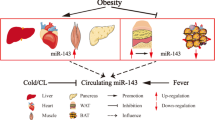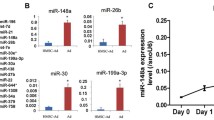Abstract
During the development of obesity, adipose tissue releases a host of different adipokines and inflammatory cytokines, such as leptin, resistin, tumor necrosis factor α (TNF-α), Interleukin-6 (IL-6), and adiponectin, which mediate insulin resistance. Recently, some microRNAs (miRNAs) regulated by adiponectin were identified as novel targets for controlling adipose tissue inflammation. Therefore, the relationship between adipokines and miRNA is worth studying. MiR-335 is an adipogenesis-related miRNA and implicated in both fatty acid metabolism and lipogenesis. In this study, we focused on the association of miR-335 and adipokines, and examined the expression trend of miR-335 during human adipocyte differentiation. Our results showed that miR-335 is significantly upregulated with treatment of leptin, resistin, TNF-α, and IL-6 in human mature adipocytes, and its expression elevated in the process of adipocyte differentiation. Interestingly, the transcriptional regulation of miR-335 by these adipokines seems independent of its host gene (mesoderm-specific transcript homolog, MEST). Thus, we cloned and identified potential promoter of miR-335 within the intron of MEST. As a result, a fragment about 600-bp length upstream sequences of miR-335 had apparent transcription activity. These findings indicated a novel role for miR-335 in adipose tissue inflammation, and miR-335 might play an important role in the process of obesity complications via its own transcription mechanism.





Similar content being viewed by others
References
Flier, J. S. (2004). Obesity wars: Molecular progress confronts an expanding epidemic. Cell, 116, 337–350.
Spiegelman, B. M., & Flier, J. S. (1996). Adipogenesis and obesity: Rounding out the big picture. Cell, 87, 377–389.
Maffei, M., Halaas, J., Ravussin, E., Pratley, R. E., Lee, G. H., Zhang, Y., et al. (1995). Leptin levels in human and rodent: Measurement of plasma leptin and ob RNA in obese and weight-reduced subjects. Nature Medicine, 1, 1155–1161.
Steppan, C. M., Bailey, S. T., Bhat, S., Brown, E. J., Banerjee, R. R., Wright, C. M., et al. (2001). The hormone resistin links obesity to diabetes. Nature, 409, 307–312.
Alexander, R., Lodish, H., & Sun, L. (2011). MicroRNAs in adipogenesis and as therapeutic targets for obesity. Expert Opinion on Therapeutic Targets, 15, 623–636.
Ling, H. Y., Hu, B., Hu, X. B., Zhong, J., Feng, S. D., Qin, L., et al. (2012). MiRNA-21 reverses high glucose and high insulin induced insulin resistance in 3T3-L1 adipocytes through targeting phosphatase and tensin homologue. Experimental and Clinical Endocrinology and Diabetes, 120, 553–559.
Yang, Y. M., Seo, S. Y., Kim, T. H., & Kim, S. G. (2012). Decrease of miR-122 causes hepatic insulin resistance by inducing protein tyrosine phosphatase 1B, which is reversed by licorice flavonoid. Hepatology, 56(6), 2209–2220.
Ge, Q., Gerard, J., Noel, L., Scroyen, I., & Brichard, S. M. (2012). MicroRNAs regulated by adiponectin as novel targets for controlling adipose tissue inflammation. Endocrinology, 153, 5285–5296.
Esau, C., Kang, X., Peralta, E., Hanson, E., Marcusson, E. G., Ravichandran, L. V., et al. (2004). MicroRNA-143 regulates adipocyte differentiation. Journal of Biological Chemistry, 279, 52361–52365.
Kajimoto, K., Naraba, H., & Iwai, N. (2006). MicroRNA and 3T3-L1 pre-adipocyte differentiation. RNA, 12, 1626–1632.
Lin, Q., Gao, Z., Alarcon, R. M., Ye, J., & Yun, Z. (2009). A role of miR-27 in the regulation of adipogenesis. FEBS Journal, 276, 2348–2358.
Nakanishi, N., Nakagawa, Y., Tokushige, N., Aoki, N., Matsuzaka, T., Ishii, K., et al. (2009). The up-regulation of microRNA-335 is associated with lipid metabolism in liver and white adipose tissue of genetically obese mice. Biochemical and Biophysical Research Communications, 385, 492–496.
Esguerra, J. L., Bolmeson, C., Cilio, C. M., & Eliasson, L. (2011). Differential glucose-regulation of microRNAs in pancreatic islets of non-obese type 2 diabetes model Goto-Kakizaki rat. PLoS One, 6, e18613.
Despres, J. P., & Lemieux, I. (2006). Abdominal obesity and metabolic syndrome. Nature, 444, 881–887.
Iozzo, P. (2009). Viewpoints on the way to the consensus session: Where does insulin resistance start? The adipose tissue. Diabetes Care, 32(Suppl 2), S168–S173.
Wagoner, B., Hausman, D. B., & Harris, R. B. (2006). Direct and indirect effects of leptin on preadipocyte proliferation and differentiation. American Journal of Physiology–Regulatory Integrative and Comparative Physiology, 290, R1557–R1564.
Liu, F., Yang, T., Wang, B., Zhang, M., Gu, N., Qiu, J., et al. (2008). Resistin induces insulin resistance, but does not affect glucose output in rat-derived hepatocytes. Acta Pharmacologica Sinica, 29, 98–104.
Wellen, K. E., Fucho, R., Gregor, M. F., Furuhashi, M., Morgan, C., Lindstad, T., et al. (2007). Coordinated regulation of nutrient and inflammatory responses by STAMP2 is essential for metabolic homeostasis. Cell, 129, 537–548.
Kralisch, S., Klein, J., Lossner, U., Bluher, M., Paschke, R., Stumvoll, M., et al. (2005). Interleukin-6 is a negative regulator of visfatin gene expression in 3T3-L1 adipocytes. American Journal of Physiology: Endocrinology and Metabolism, 289, E586–E590.
Schmittgen, T. D., & Livak, K. J. (2008). Analyzing real-time PCR data by the comparative C(T) method. Nature Protocols, 3, 1101–1108.
Kobayashi, S., Kohda, T., Miyoshi, N., Kuroiwa, Y., Aisaka, K., Tsutsumi, O., et al. (1997). Human PEG1/MEST, an imprinted gene on chromosome 7. Human Molecular Genetics, 6, 781–786.
Friedman, J. M., & Halaas, J. L. (1998). Leptin and the regulation of body weight in mammals. Nature, 395, 763–770.
Silha, J. V., Krsek, M., Skrha, J. V., Sucharda, P., Nyomba, B. L., & Murphy, L. J. (2003). Plasma resistin, adiponectin and leptin levels in lean and obese subjects: Correlations with insulin resistance. European Journal of Endocrinology, 149, 331–335.
Kloting, N., Berthold, S., Kovacs, P., Schon, M. R., Fasshauer, M., Ruschke, K., et al. (2009). MicroRNA expression in human omental and subcutaneous adipose tissue. PLoS One, 4, e4699.
Way, J. M., Gorgun, C. Z., Tong, Q., Uysal, K. T., Brown, K. K., Harrington, W. W., et al. (2001). Adipose tissue resistin expression is severely suppressed in obesity and stimulated by peroxisome proliferator-activated receptor gamma agonists. Journal of Biological Chemistry, 276, 25651–25653.
Juan, C. C., Au, L. C., Fang, V. S., Kang, S. F., Ko, Y. H., Kuo, S. F., et al. (2001). Suppressed gene expression of adipocyte resistin in an insulin-resistant rat model probably by elevated free fatty acids. Biochemical and Biophysical Research Communications, 289, 1328–1333.
Hotamisligil, G. S., Shargill, N. S., & Spiegelman, B. M. (1993). Adipose expression of tumor necrosis factor-alpha: Direct role in obesity-linked insulin resistance. Science, 259, 87–91.
Liu, S., Yang, Y., & Wu, J. (2011). TNFalpha-induced up-regulation of miR-155 inhibits adipogenesis by down-regulating early adipogenic transcription factors. Biochemical and Biophysical Research Communications, 414, 618–624.
Ron, D., Brasier, A. R., McGehee, R. J., & Habener, J. F. (1992). Tumor necrosis factor-induced reversal of adipocytic phenotype of 3T3-L1 cells is preceded by a loss of nuclear CCAAT/enhancer binding protein (C/EBP). Journal of Clinical Investigation, 89, 223–233.
Xing, H., Northrop, J. P., Grove, J. R., Kilpatrick, K. E., Su, J. L., & Ringold, G. M. (1997). TNF alpha-mediated inhibition and reversal of adipocyte differentiation is accompanied by suppressed expression of PPARgamma without effects on Pref-1 expression. Endocrinology, 138, 2776–2783.
Stouthard, J. M., Oude, E. R., & Sauerwein, H. P. (1996). Interleukin-6 enhances glucose transport in 3T3-L1 adipocytes. Biochemical and Biophysical Research Communications, 220, 241–245.
Ellingsgaard, H., Hauselmann, I., Schuler, B., Habib, A. M., Baggio, L. L., Meier, D. T., et al. (2011). Interleukin-6 enhances insulin secretion by increasing glucagon-like peptide-1 secretion from L cells and alpha cells. Nature Medicine, 17, 1481–1489.
Shu, M., Zhou, Y., Zhu, W., Zhang, H., Wu, S., Chen, J., et al. (2012). MicroRNA 335 is required for differentiation of malignant glioma cells induced by activation of cAMP/protein kinase A pathway. Molecular Pharmacology, 81, 292–298.
McArdle, M. A., Finucane, O. M., Connaughton, R. M., McMorrow, A. M., & Roche, H. M. (2013). Mechanisms of obesity-induced inflammation and insulin resistance: Insights into the emerging role of nutritional strategies. Frontiers in Endocrinology (Lausanne), 4, 52.
McGillicuddy, F. C., Chiquoine, E. H., Hinkle, C. C., Kim, R. J., Shah, R., Roche, H. M., et al. (2009). Interferon gamma attenuates insulin signaling, lipid storage, and differentiation in human adipocytes via activation of the JAK/STAT pathway. Journal of Biological Chemistry, 284, 31936–31944.
Chung, S., Lapoint, K., Martinez, K., Kennedy, A., Boysen, S. M., & McIntosh, M. K. (2006). Preadipocytes mediate lipopolysaccharide-induced inflammation and insulin resistance in primary cultures of newly differentiated human adipocytes. Endocrinology, 147, 5340–5351.
Neville, M. J., Collins, J. M., Gloyn, A. L., McCarthy, M. I., & Karpe, F. (2011). Comprehensive human adipose tissue mRNA and microRNA endogenous control selection for quantitative real-time-PCR normalization. Obesity (Silver Spring), 19, 888–892.
Nikonova, L., Koza, R. A., Mendoza, T., Chao, P. M., Curley, J. P., & Kozak, L. P. (2008). Mesoderm-specific transcript is associated with fat mass expansion in response to a positive energy balance. FASEB J, 22, 3925–3937.
Takahashi, M., Kamei, Y., & Ezaki, O. (2005). Mest/Peg1 imprinted gene enlarges adipocytes and is a marker of adipocyte size. American Journal of Physiology: Endocrinology and Metabolism, 288, E117–E124.
Acknowledgments
This Project was supported by Grants from the National Key Basic Research Program of China (2013CB530604), Program for Innovative Research Teams of Jiangsu Province (LJ201108), Nanjing Technological Development Program (201104013), and the Postgraduate Program for Innovative Research of Jiangsu Province Higher Education Institutions (CXLX12-0565).
Author information
Authors and Affiliations
Corresponding authors
Additional information
Lu Zhu and Ling Chen contributed equally to this work.
Electronic supplementary material
Below is the link to the electronic supplementary material.
12013_2013_9708_MOESM1_ESM.tif
Supplementary material 1 (TIFF 395 kb). The construct of pTB-Cherry vector. This vector was designed for analyzing the promoter activity by observing red fluorescence under fluorescence microscope. We blocked TA minimal promoter (PTA) and replaced luciferase (Luc) gene using mCherry gene to form the 3861bp pTB-Cherry vector
Rights and permissions
About this article
Cite this article
Zhu, L., Chen, L., Shi, CM. et al. MiR-335, an Adipogenesis-Related MicroRNA, is Involved in Adipose Tissue Inflammation. Cell Biochem Biophys 68, 283–290 (2014). https://doi.org/10.1007/s12013-013-9708-3
Published:
Issue Date:
DOI: https://doi.org/10.1007/s12013-013-9708-3




